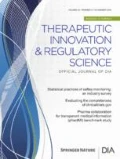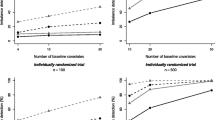Abstract
Many randomized studies in small patient populations and studies in early research (such as Phase I and Phase II trials) have small to moderate numbers of patients. In such studies the use of simple randomization or blocking on only one or two factors can easily result in imbalance between treatment groups with respect to one or more potentially prognostic variables. Baseline adaptive randomization methods (such as biased coin methods) can be used to virtually guarantee balance between treatment groups with respect to several covariates. One such method, which has been implemented in Splus, is discussed in detail. The impact of the baseline adaptive randomization method on the nominal distribution of the analysis of covariance test statistic is also discussed. Rather than relying solely on the assumption that the distribution of the analysis of covariance test statistic has its nominal distribution when adaptive randomization is used, a mechanism in Splus has been developed to perform a randomization test taking into account all of the constraints imposed by the chosen adaptive randomization procedure.
Similar content being viewed by others
References
Lord FM. A paradox in the interpretation of group comparisons. Psychological Bull. 1967;68:304–305.
Harville DA. Nearly optimal allocation of experimental units using observed covariate values. Technometrics. 1974;16:589–599.
Pocock SJ, Simon R. Sequential treatment assignment with balancing for prognostic factors in the controlled clinical trial. Biometrics. 1975;31:103–115.
Taves DR. Minimization: A new method of assigning patients to treatment and control groups. Clin Pharmacol Therapeutics. 1974;15:443–453.
Pocock SJ. Allocation of patients to treatments in clinical trials. Biometrics. 1979;35:183–197.
Simon R. The Consultant’s Forum: Restricted randomization designs in clinical trials. Biometrics. 1979;35:503–512.
Begg CB, Iglewicz B. A treatment allocation procedure for sequential clinical trials. Biometrics. 1980;36:81–90.
Atkinson AC. Optimum biased coin designs for sequential clinical trials with prognostic factors. Biometrika. 1982;69:61–67.
Smythe RT, Wei LI. Significance tests with restricted randomization design. Biometrika. 1983;70:496–500.
Smith RL. Sequential treatment allocation using biased coin designs. J R Stat Soc B. 1984;46(3):519–543.
Halpern J, Brown BW. Sequential treatment allocation procedures in clinical trials—with particular attention to the analysis of results for the biased coin design. Stat Med. 1986;5:211–229.
Hanningan JF, Brown BW. Adaptive randomization biased coindesign: experience in a cooperative group clinical trial. Technical Report No. 74, Division of Biostatistics, Stanford University, Stanford, CA.
Hollander M, Pena E. Nonparametric test under restricted treatment-assignment rules. J Am Stat Assoc. 1988;83:1144–1151.
Begg CB. On inferences from Wei’s biased coin design for clinical trails. Biometrika. 1990;77(3):467–484.
Efron B. Forcing a sequential experiment to be balanced. Biometrika. 1971;58:403–417.
Efron B. Randomizing and balancing a complicated sequential experiment. In: Biostatistics Casebook. Miller Jr RG, Efron B. Brown Jr BW, Moses LE, eds. New York: Wiley; 1980:19–30.
Becker RA, Chambers JM, Wilks AR. The New S Language: A Programming Environment for Data Analysis and Graphics. Pacific Grove, California: Wadsworth & Brooks/Cole; 1988.
Forsythe AB, Stitt FJ. Randomization or minimization in the treatment assignment of patient trials: validity and power of tests. Technical Report 28, Health Sciences Computing Facility, University of California, Los Angeles; 1977.
Therneau T. How many stratification factors are “too many” to use in a randomization plan? Control Clin Trials. 1993;14:98–108.
Author information
Authors and Affiliations
Rights and permissions
About this article
Cite this article
Frane, J.W. A Method of Biased Coin Randomization, Its Implementation, and Its Validation. Ther Innov Regul Sci 32, 423–432 (1998). https://doi.org/10.1177/009286159803200213
Published:
Issue Date:
DOI: https://doi.org/10.1177/009286159803200213




